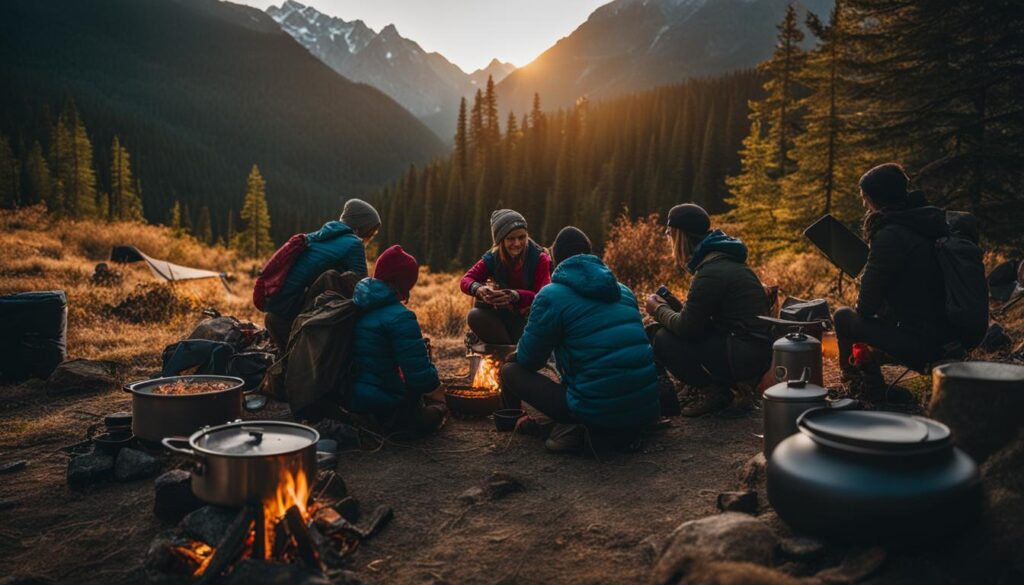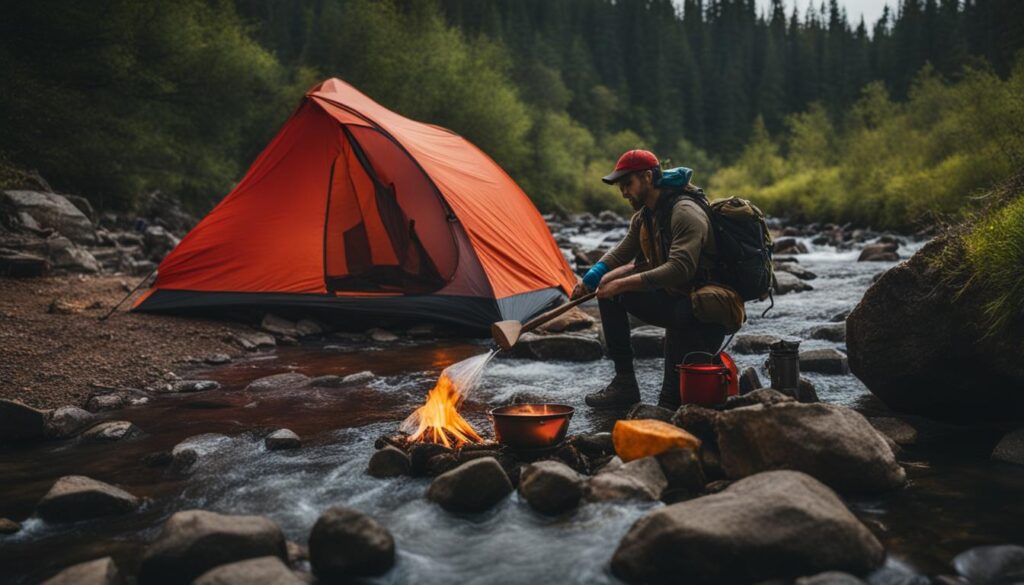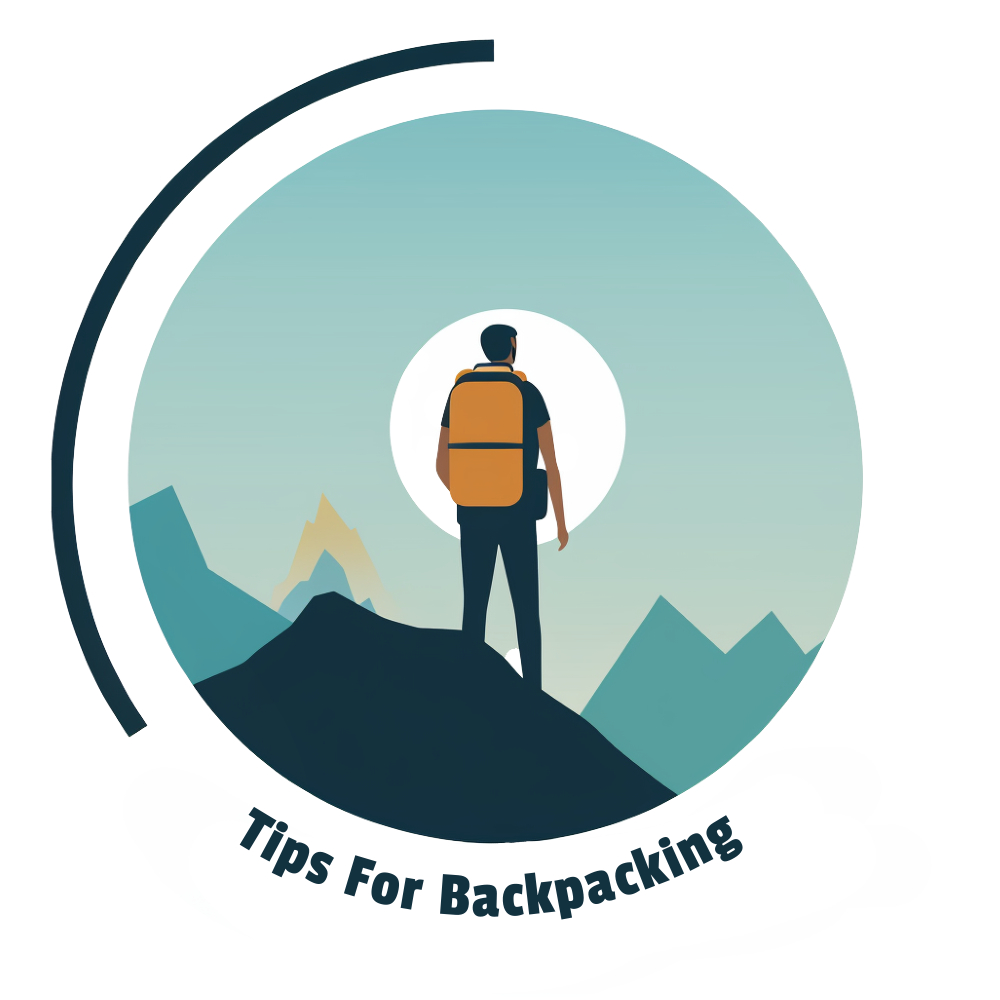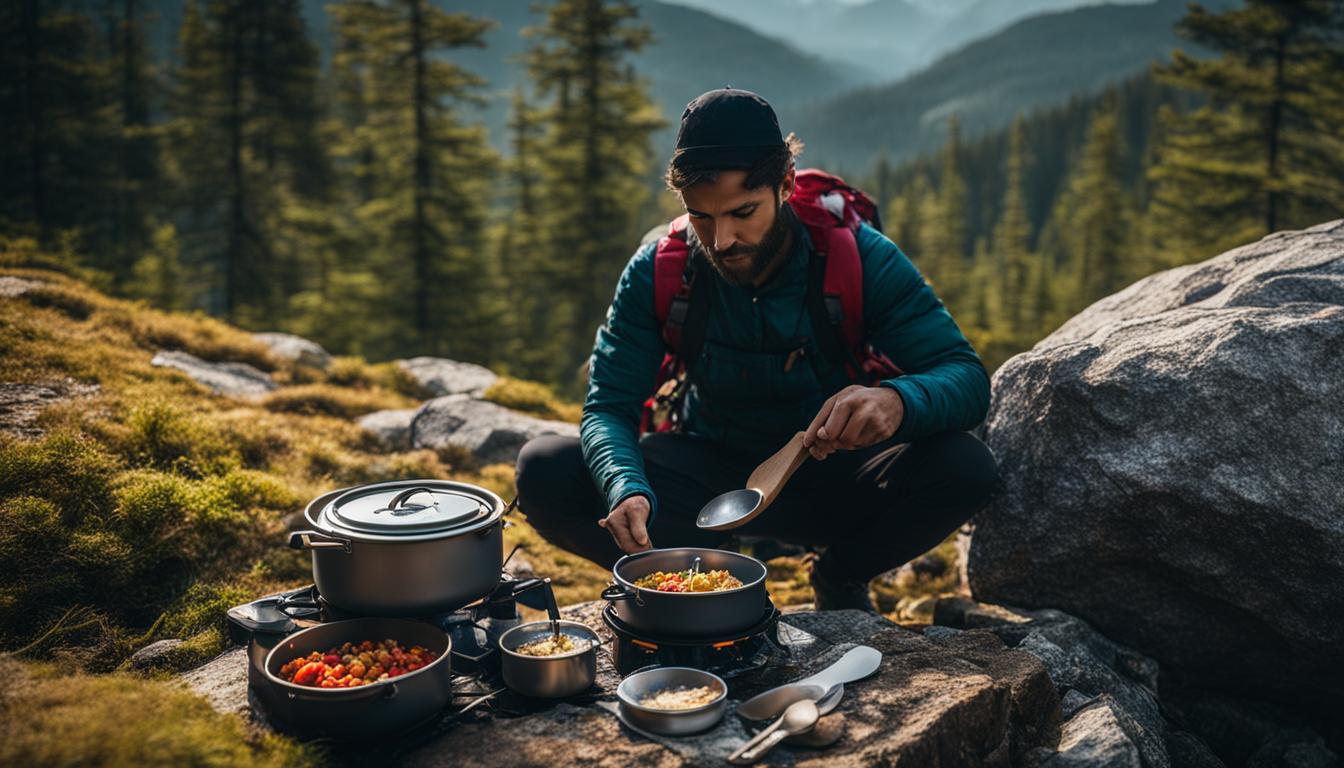When it comes to cooking while backpacking, safety and efficiency should be your top priorities. As an avid backpacker myself, I know the importance of preparing meals that are not only delicious but also adhere to proper food handling techniques in the wilderness.
In this article, I will share with you my top backpacking cooking tips and campfire cooking techniques to ensure you have a successful and enjoyable cooking experience on your outdoor adventures.
Key Takeaways:
- Choose lightweight camping cookware that is durable and easy to pack
- Invest in a compact stove with fuel efficiency
- Practice safe food handling by planning meals ahead and following proper hygiene
- Consider using freeze-dried meals and dehydrated foods for minimal weight and preparation time
- Properly store leftovers and dispose of food waste responsibly
Essential Backpacking Cooking Equipment

When it comes to cooking while backpacking, having the right equipment can make all the difference. Investing in high-quality camping cookware that is lightweight and durable is essential for a successful outdoor cooking experience. Look for pots and pans that are easy to pack and clean, and consider opting for multi-purpose items to save space in your backpack.
One popular option is a pot with a lid that can also double as a bowl. This eliminates the need to carry multiple containers and reduces the overall weight of your pack. Additionally, using lightweight freeze-dried meals and dehydrated foods can help minimize weight and preparation time, making them perfect for a backpacking adventure.
Another crucial piece of equipment to consider is a compact stove with fuel efficiency. This ensures that you have a reliable and convenient cooking method, even in remote areas. Look for stoves that are designed to conserve fuel, allowing you to cook multiple meals without having to carry excessive amounts of fuel with you.
Don’t forget to pack essential utensils such as a lightweight knife, spoon, and spatula. These tools will come in handy when preparing meals in the backcountry. By investing in the right cooking equipment, you can cook safely, efficiently, and enjoy delicious meals while backpacking.
Backcountry Cooking Hacks
When you’re out in the wilderness, it’s important to have a few tricks up your sleeve to make cooking easier and more enjoyable. Here are some backcountry cooking hacks to help you maximize your outdoor cooking experience:
- Pre-measure ingredients: Before you head out on your backpacking trip, pre-measure ingredients for your meals and pack them in ziplock bags. This will save you time and ensure that you have everything you need.
- Use aluminum foil: Aluminum foil is a versatile tool in the backcountry. You can use it to wrap food, create makeshift bowls or plates, and even cook meals over an open fire.
- Opt for one-pot meals: Cooking and cleaning up can be a hassle while backpacking. Choose one-pot meals that require minimal preparation and cleanup, such as pasta dishes or stir-fries.
- Plan for leftovers: If you have leftovers, don’t let them go to waste. Plan ahead by bringing containers or resealable bags to store any extra food for future meals.
By incorporating these backcountry cooking hacks into your backpacking trip, you’ll be able to cook delicious meals with ease, leaving you more time to enjoy the great outdoors.
Table: Comparison of Lightweight Camping Cookware
| Cookware Set | Weight | Durability | Features |
|---|---|---|---|
| Brand A | 12 oz | High | Non-stick coating, collapsible handles |
| Brand B | 10 oz | Medium | Compact design, nesting capability |
| Brand C | 16 oz | High | Hard-anodized aluminum, heat-resistant handles |
Table: Comparison of lightweight camping cookware options. Features include weight, durability, and special features such as non-stick coatings or collapsible handles. Consider these factors when choosing the best cookware set for your backpacking needs.
Safe Food Handling in the Wilderness

When venturing into the wilderness, proper food handling is essential to ensure your health and prevent foodborne illnesses. Follow these guidelines to stay safe and make the most of your backpacking experience.
Plan your meals ahead
Meal planning plays a vital role in ensuring you have enough food for your backpacking trip without carrying excess weight. Research and choose easy camping recipes that require minimal ingredients and preparation time. Consider dehydrated or freeze-dried foods, as they are lightweight and easy to pack. These options also have a longer shelf life, reducing the risk of spoilage.
Practice good hand hygiene
Keeping your hands clean is crucial when handling food in the wilderness. Wash your hands with soap and water for at least 20 seconds before and after handling food. If there is no water available, use hand sanitizer with at least 60% alcohol content. This simple step helps eliminate harmful bacteria and reduces the risk of cross-contamination.
Keep perishable foods cold
To prevent the growth of bacteria, it’s important to keep perishable foods cold during your backpacking trip. Pack them in an insulated cooler with ice packs or use a lightweight cooler bag. Organize your cooler strategically to minimize temperature fluctuations. Place raw meat, poultry, and seafood in separate containers to avoid cross-contamination.
Cook food thoroughly
When cooking in the wilderness, it’s crucial to ensure your food reaches a safe internal temperature. Invest in a reliable food thermometer and use it to check the internal temperature of meat, poultry, and fish. The USDA recommends cooking poultry to a minimum internal temperature of 165°F (74°C), ground meat to 160°F (71°C), and beef, pork, veal, and lamb to 145°F (63°C) with a three-minute rest time. Properly cooked food eliminates harmful bacteria and reduces the risk of foodborne illnesses.
Store leftovers and dispose of waste responsibly
After enjoying a delicious meal in the wilderness, make sure to store any leftovers properly. Use airtight containers to keep food fresh and avoid cross-contamination. Dispose of food waste responsibly by following Leave No Trace principles. Pack out any non-biodegradable waste and bury organic waste at least 200 feet away from water sources.
| Food Safety Tips | Summary |
|---|---|
| Plan your meals ahead | Choose easy camping recipes and pack lightweight, dehydrated or freeze-dried foods. |
| Practice good hand hygiene | Wash hands with soap and water or use hand sanitizer before and after handling food. |
| Keep perishable foods cold | Use an insulated cooler or cooler bag with ice packs to prevent bacterial growth. |
| Cook food thoroughly | Use a food thermometer to ensure food reaches safe internal temperatures. |
| Store leftovers and dispose of waste responsibly | Use airtight containers for leftovers and follow Leave No Trace principles for waste disposal. |
What Are Some Safety Tips for Cooking While Backpacking?
When it comes to cooking while backpacking, it’s important to use the right cooking gear for backpacking. Always remember to set up your cooking area on stable ground and away from anything flammable. Keep a close eye on your food while it’s cooking and never leave it unattended.
Conclusion
Cooking safely and efficiently while backpacking is a breeze when you have the right knowledge and preparation. By investing in lightweight camping cookware and practicing safe food handling, you can enjoy delicious meals in the wilderness without any worries. Plus, utilizing stove fuel efficiency is a great way to make the most of your cooking experience.
With the right equipment, such as a compact stove and lightweight cookware, you can cook up a storm while keeping your backpack light and your meals tasty. Make sure to prioritize fuel efficiency to ensure you have enough cooking fuel for the duration of your trip.
By following safe food handling practices, like proper hand hygiene and cooking food to the recommended temperature, you can prevent foodborne illnesses and keep yourself healthy on the trails. Don’t forget to plan your meals ahead of time and consider easy camping recipes that require minimal preparation and ingredients.
So, next time you head out on a backpacking adventure, be confident in your cooking skills. With a little preparation and the right techniques, you can create culinary wonders in the great outdoors. Happy cooking!

